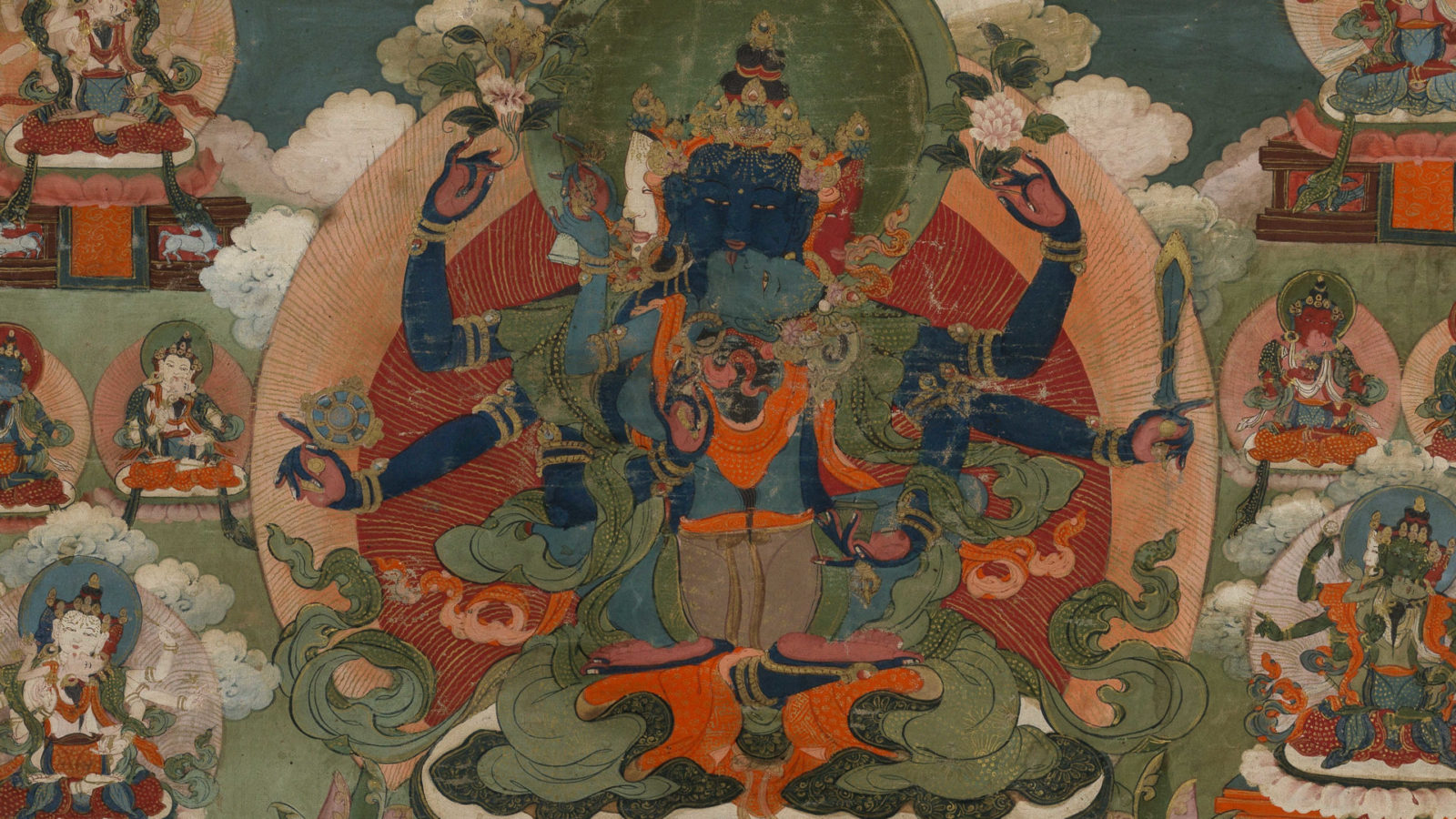A Buddha sits with one hand touching the earth, and his body is green with living leaves and flowers. Lama Tashi Norbu sees the rings of petals in two forms at once — the lotuses of his Tibetan tradition and the tulips of his new home in the Netherlands.
“We have to grow out of this muddy water,” he said, “like the lotus grows in this muddy water, where the world is sufferings and happiness — everything is in it, like that — and then (we are) surviving through it.”
He was speaking from his own museum and cultural center, the Museum of Contemporary Tibetan Art in Emmen, near Amsterdam, as an internationally known artist trained in Tibetan Thangka painting and in Western art, and as one of a community of Tibetan artists around the world.
‘We have to grow out of this muddy water like a lotus grows.’ — Lama Tashi Norbu
Norbu will come to Williamstown as an artist in residence in the spring, and in February he will join in a conversation with traditional Tibetan art in Across Still Waters, a group art show at the Williams College Museum of Art — with contemporary Tibetan artists around the world, from Australia to America, Tibet and Tibetan areas of China.
Like Norbu, many of them have left Tibet, or have never lived there, because their home country and culture are under threat, and he sees clearly a vital need to create spaces to preserve their culture for the future.
“We have to do it, Tibetans,” he said, “for our culture to survive.”
‘We have to do it, Tibetans, for our culture to survive.’
The new show at WCMA grows out of a gift of traditional Tibetan artwork. A year ago, Jack Shear reached out to the college, and to two others. He is an artist, photographer, curator and collector, in New York City and Spencertown N.Y. — and longtime partner of contemporary artist Ellsworth Kelly. He now directs the Ellsworth Kelly Foundation.
In spring 2022, Spear made a gift of traditional Tibetan artwork to Skidmore, Vassar and Williams Colleges, said Ariana Maki, Associate Director of the University of Virginia Tibet Center and Bhutan Initiative, speaking on zoom from Charlottesville.
The three colleges first asked her to come up and look through the collection and then to guest curate exhibits at Vassar and now at Williams, as she will co-curate an upcoming show at Skidmore.
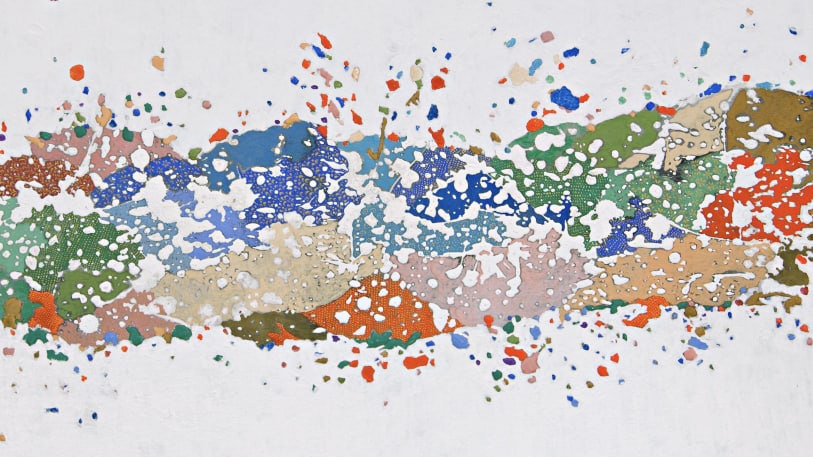
Abstract Sound #4 shows color in ground mineral pigment on a wooden panel. Pema Rinzin was born 1966 in Tibet and lives and works in New York. Press image courtesy of the artist and WCMA
Artists span past and present
“What impressed me about the Shear collection is the … sheer number of works available for us to draw on,” she said. “They touch on a number of aspects of Tibetan philosophy and practice.”
Begining with traditional artworks, she has brought together a wide-ranging group of Himalayan and Tibetan contemporary artists, to interact with them. These living artists are invoking traditions and artforms of their homelands, she said, and creating their own work — completely new, distinct and compelling.
The show begins for her in four Thangkas, Tibetan Buddhist paintings a hundred to 400 years old, though the form goes back more than 1500 years. Traveling monks would bring them to towns and villages, to teach.
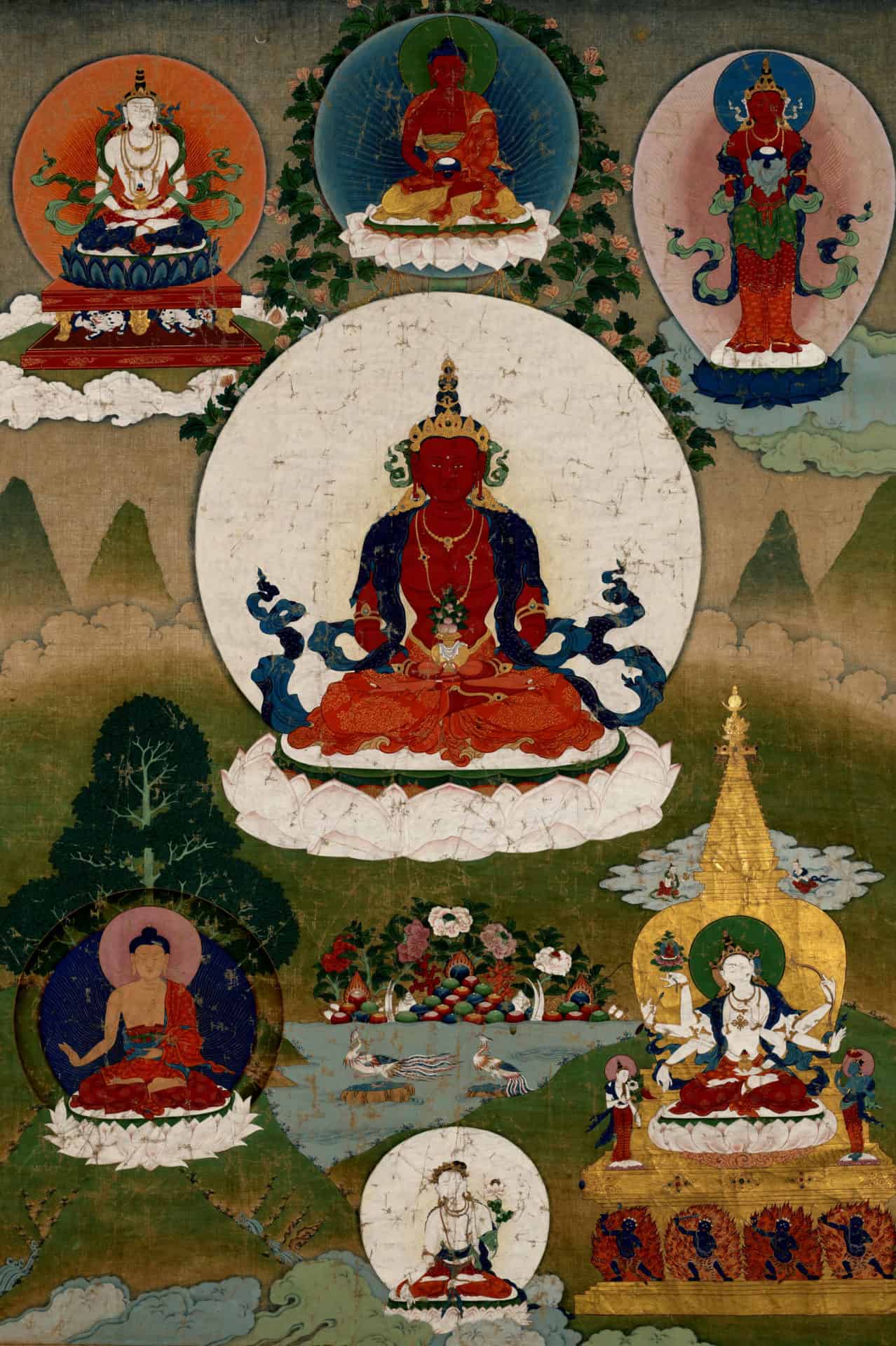
Tsepakmé, the Buddha of Unlimited Life, 19th century. Distemper on cloth, Eastern Tibet style. Maker(s) not known by WCMA. The Jack Shear Collection of Himalayan Art
For her the thangkas can open ways into contemporary themes, she said — in their stories, she traces the forces a family can put on the people within it, or society on one person, or traditions on people who carry them. And she turns to contemporary artists to ask how people navigate those forces, past and present, and the sense of place they have in the world.
Accepting flower culture
In his painting, Norbu looks to some of his earliest experiences in the West. He has had to leave his home and start again, and he recognizes the effort and challenge in learning a new place.
When he came to the Netherlands, he said, he and his brothers, would travel together. Two of them are monks as well, and they would hold events, opening art exhibitions and making sand mandalas. And people would bring them flowers. He struggled with the idea that people had cut flowers as a gift.
“For us, a flower is a living substance,” he said. “We wouldn’t do that in Tibet. … But we tried to look at the intentions of the people bringing them.”
So he thought about adapting to a new culture, and about an idea in Tibetan culture and poetry — ‘Be the flower, not the bee.’
‘We grow from this chaotic life and then shine beautifully like that to the bees, and then they come to us.’ — Lama Tashi Norbu
“The lotus … survives through the deepest part of the water,” he said, “until (he reaches) the surface of the water, until he blooms. We grow from this chaotic life, growing up, and then shine beautifully like that to the bees, and then they come to us.”
So he combined these ideas, he said, as he combines being a contemporary artist and a monk.
“We don’t have to search somewhere else, like the bee does,” he said. “The happiness is lying within you. And then the action has to be like the bees — we are sowing the seeds for things to grow.”
Global Tibet
Contemporary artists in Across Shared Waters include Marie-Dolma Chophel, Dedron, Nyema Droma, Gonkar Gyatso, Tenzin Norbu Lama, Kesang Lamdark, Tashi Norbu, Karma Phuntsok, Pema Rinzin, Rabkar Wangchuk and Palden Weinreb.
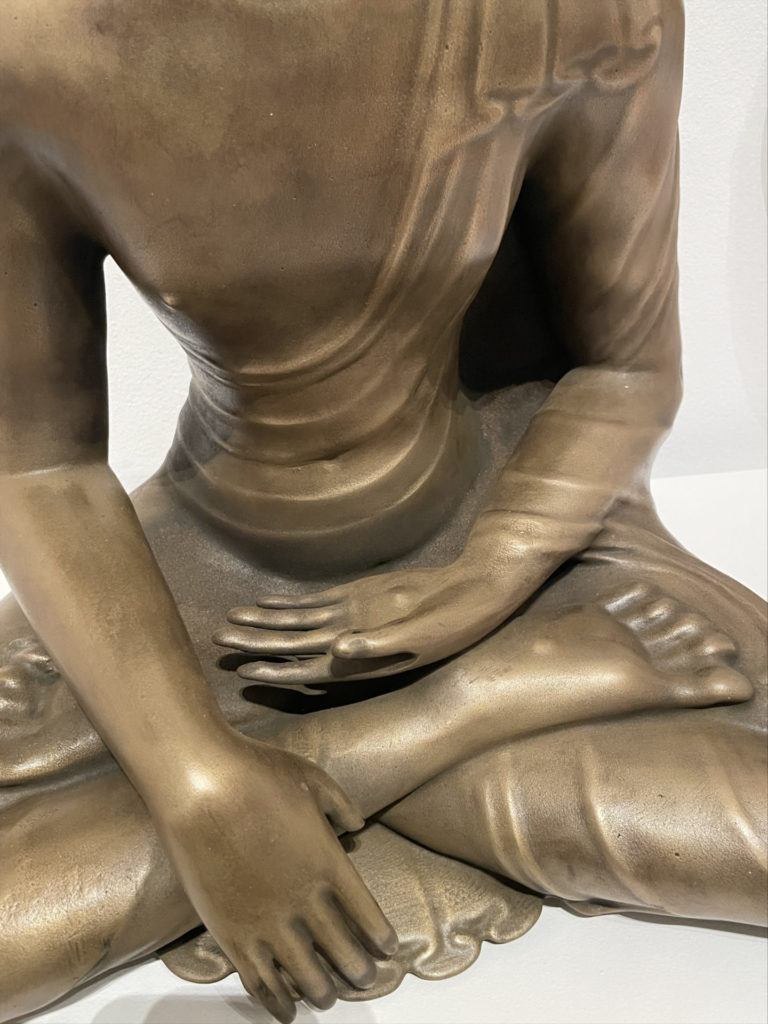
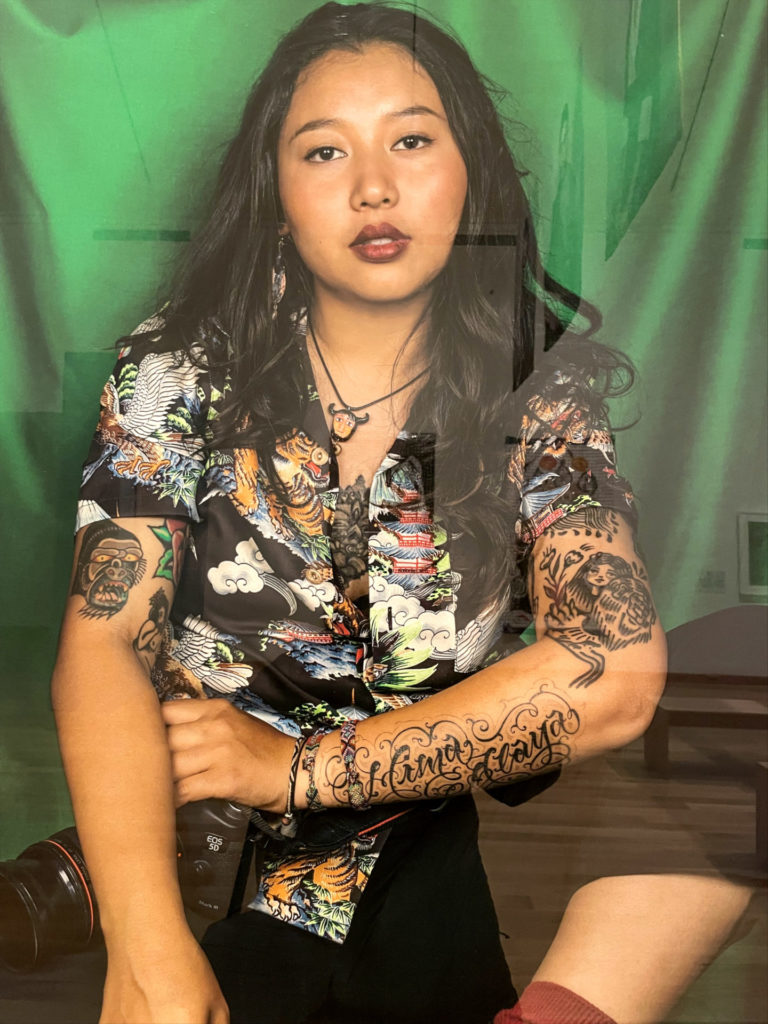
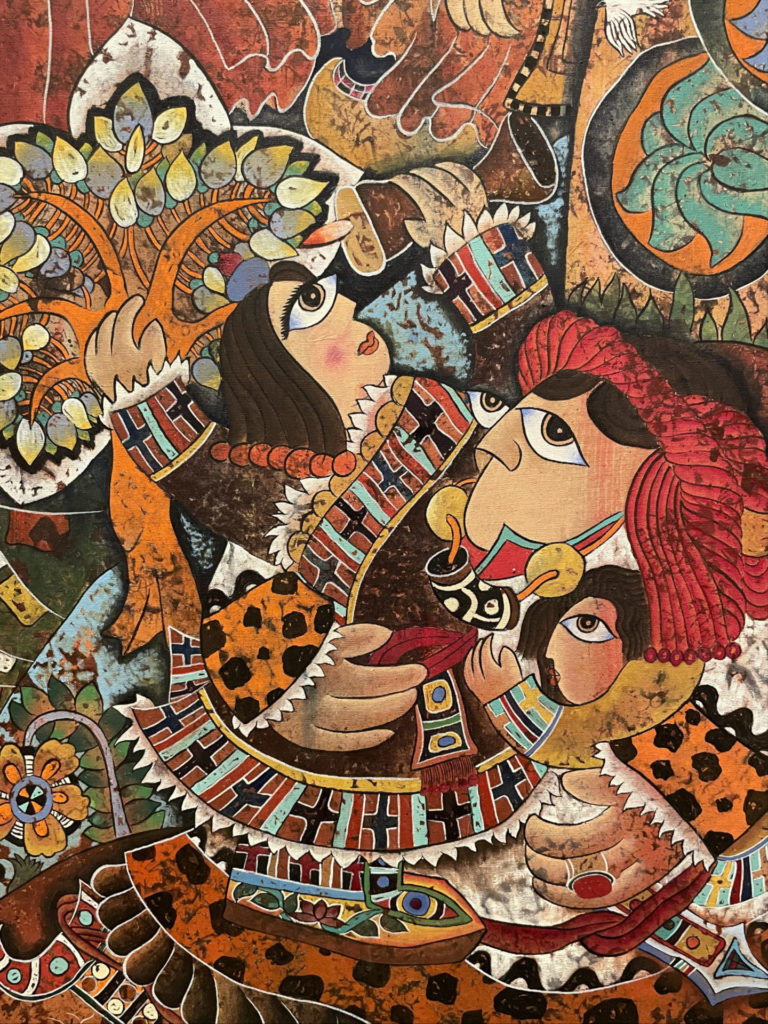


Gonkar Gyatso’s bronze and resin Buddhas appear in conversation with Nyema Droma’s photographs, Dendron’s pilgrims, Pema Renzin’s mandala filled with birds and Marie-Dolma’s abstractions.
Mapping the Tibetan diaspora
In this show, Norbu will set his work in conversation with artworks around him and artists like Gonkar Gyatso.
Maki sees Gyatso as part of an earlier generation of artists, like Karma Phuntsok, that have had a global influence. They have broken trail for Tibetan artists around the world.
“They have each taken a different path to their ways of working and where they live,” Maki said. “They have catalyzed one or two generations of artists in the Himalaya who are experiencing their own successes now thanks to the worldwide attention that Gonkar brought and others brought.”
‘They have catalyzed one or two generations of artists in the Himalaya.’ — Ariana Maki
Like Norbu, Gyatso has received formal training in Thangka painting, Maki said — and like Norbu, in his work here Gyatso responds to a traditional Thangka, a painting of the Shakyamuni Buddha. But while the traditional thangka shows Shakyamuni surrounded by his past lives, Gonkar has placed his Buddha surrounded by what’s happening now, what he is experiencing in this life.
“To me it was speaking to a lived present, but also an uncertain future,” Maki said. “When the Buddha was in his past life, he didn’t know on what trajectory he would ultimately land.”
In answer to still more current events, Gyatso has also offered her a work he has created in the pandemic, in October 2021 — surrounded by experiences he had while living in China during the rise of Covid and lock-down policy. She feels in it a very human response to very surreal and often overwhelming situation.

Australian patterns and Tibetan ritual elements combine in Dorje and Dilbu, by Karma Phuntsok. Press image courtesy of WCMA and Shelley and Donald Rubin Private Collection.
Abstraction and meditation
Phuntsok, like Norbu, blends ritual and natural elements from Tibet and from a distant place where he now lives. He centers implements that often appear in the hands of deities, and today in the hands of human teachers, Maki said. And around them he sets patterns of concentric circles often represented in Aboriginal arts in his new homeland of Australia.
He is representing two streams that have come together in his life, Maki said, and she sees echoes, resonances, in the meditative quality in rings of concentric circles, mandalas and circular walking paths, and the state an artist might be in to create them — the repetition and cadence of creation an artist might experience.
Abstraction has a place in this visual conversation, Maki said, looking closely toward Pima Renzin’s vivid colors and patterns.
She first met Pima Renzin met in 2008, when she was serving at the Rubin Museum of Art in New York, dedicated to arts and cultures of the Himalaya, and he was an artist in residence, creating paintings live in public for anyone to see.
‘Pima was trained by some of the foremost master artists in Dharamsala, India,” she said, “and so his brushwork is absolutely sublime.’
“Pima was trained by some of the foremost master artists in Dharamsala, India,” she said, “and so his brushwork is absolutely sublime. It looks like it is just a flat application of color, but it is the addition of hundreds and thousands of brushstrokes, just done in such a masterful way that it gives the appearance of a flat, uniform surface, but the amount of time and attention to detail in the skill of wielding the brush is phenomenal.”
Since then he has been teaching, she said, and working in more abstract forms, in dynamic and varied compositions that often travel internationally.
“He has two works in the show, Abstract Sound No. 4 and Bird Mandela,” she said, “and if you put them next to each other you wouldn’t think they were done by the same artist. His work is wide-ranging and thought-provoking.”

Fourth Dalai Lama Yönten Gyatso (1589–1617), 19th century. Distemper on cloth, Central Tibetan style. Maker(s) not known by WCMA. The Jack Shear Collection of Himalayan Art
She traces fine detail in his washes of deep blue, cornflower blue and camel-dun — goldwork like the symbol of a lotus on a monk’s robe, golden leaves and petalled flowers found on textiles, a swirl on dark green like a cloud-scroll motif, a way of creating cloud or water, a grain motif and one like stylized gems.
“What made me think of Pima is how his life in some ways is emblematic of what the entire exhibition is trying to do.,” she said. “He’s so well grounded in and thoroughly versed in traditional techniques, which are … awe-inspiring, quite honestly, and he’s also deftly expressing himself in these innovative ways.”
With a storm-cloud churning, Marie-Dolma Chophel sets her work in motion with a force of energy in their color and movement.
Maki came to her thinking of another traditional work in the collection, a meditational diagram used for people initiated into a practice — the work recalled Chophel’s for her in its use of space and its use of senses.
“Mandalas tend to give a mental map, a guidance for the mind,” she said.
Someone meditating will think of aspects of the environment and the body in very precise ways. They will envision the world around them, conjure sights and sounds and smells and acts. And Chophel’s work gives her a cosmic sense of perspective.
“We’re working through space and our ideas of ourselves,” Maki said. “We’re here on this earth, and the more that we learn about the earth — we are a very rare space that can foster this diversity of life, diversity of cultures. The more that we look out through James Webb or Hubble or any of these telescopes, we are not finding others like us.”
‘We’re here on this earth, and the more that we learn about the earth — we are a very rare space that can foster this diversity of life.’ — Ariana Maki
In Chophel’s work, she feels a sense of place as physical and mental, abstract and real at the same time.
She compares that vision to meditation as a practice, which aims to see each living element, like the bud of a flower, as real and complex and alive — and at the same time, to recognize when what someone is seeing is not part of the flower, but part of them. They learn to tell the difference between the opening petals and sepals and calyxes … and their own experience or perception.
“My idea was to create a space that would give a sense that all elements (earth, wind, fire, water and space) are in constant conversation,” Chophel told her — “interconnected and interdependent — whether we think of the outside world or the conditions for the existence of sentient beings, both physically and on the level of consciousness (internal conversation, conflicts and resolutions it implies).”
Chophel embeds her artwork in the natural world, and in the world beyond the natural world, Maki said: “Our internal worlds that inhabit the natural word, but we also have the capacity to go far beyond through our imaginations.”

